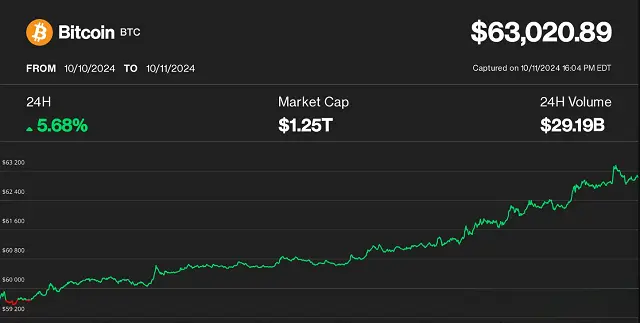Bitcoin’s remarkable 7% jump, crossing the $63K mark, has reignited discussions about its future trajectory. Many investors and analysts attribute this surge to global economic shifts, notably China’s latest stimulus measures. As the world’s second-largest economy continues to maneuver through its economic challenges, the ripple effects are increasingly felt across global markets, including cryptocurrencies.

In this article, we will break down the factors driving Bitcoin’s recent surge, explore China’s economic stimulus efforts, and analyze how these developments could impact the broader cryptocurrency landscape. By delving deeper into these subjects than current coverage, we aim to provide a comprehensive guide to understanding these complex dynamics.
Table of Contents
Why Bitcoin Surged Above $63K
Bitcoin’s recent spike is more than just a reflection of typical market volatility. A key driving factor is the anticipation of China’s economic stimulus package, designed to support its slowing economy. While the cryptocurrency market is no stranger to rapid price changes, Bitcoin’s current rally comes at a time of global economic uncertainty, which has traders and analysts alike wondering about its sustainability.
The China Connection
China’s stimulus measures, which are aimed at stabilizing its post-pandemic economy, have triggered widespread reactions across global financial markets. Though China’s government maintains a hardline stance on cryptocurrency use within its borders, the interconnectedness of global markets means that any major economic shifts in China inevitably affect global investor sentiment.
This latest stimulus is focused on infrastructure spending, tax breaks for businesses, and reducing borrowing costs. The infusion of liquidity into the economy provides a potential boost to risk assets like Bitcoin. Global investors, always on the lookout for yield, may see this as an opportunity to increase their crypto holdings, anticipating a knock-on effect that boosts cryptocurrency valuations.
China’s Economic Stimulus Explained
China’s recent stimulus package includes several key elements aimed at rejuvenating growth, such as:
- Infrastructure Investments: Large-scale public infrastructure projects are set to stimulate domestic demand and create jobs. For investors, this signals increased liquidity and potential economic stabilization.
- Monetary Easing: The People’s Bank of China (PBoC) has lowered borrowing rates, making capital more accessible. This typically results in higher risk appetite in global markets, including cryptocurrencies.
- Support for Small Businesses: With small and medium-sized enterprises (SMEs) being crucial to China’s economic recovery, tax relief measures have been introduced. Although these policies seem far removed from Bitcoin, they contribute to the broader economic sentiment that can influence risk asset investments.
As the global economy continues to grapple with inflation, geopolitical tensions, and energy crises, China’s efforts to stimulate its economy offer a sense of cautious optimism to traders.
The Role of Macroeconomic Trends in Bitcoin’s Price
While China’s stimulus is a significant short-term driver, Bitcoin’s price action cannot be understood in isolation from broader macroeconomic trends. These include:
U.S. Federal Reserve Policy
The Federal Reserve’s tightening or loosening of monetary policy has a profound impact on Bitcoin and other cryptocurrencies. The Fed’s stance on interest rates influences the U.S. dollar’s strength, inflation, and investor risk appetite. The recent reduction in rate hikes is seen as a bullish sign for risk assets, contributing to Bitcoin’s rally.
Geopolitical Tensions
Geopolitical tensions, especially between major economies like the U.S. and China, also play a role in shaping market sentiment. Cryptocurrencies, especially Bitcoin, have been viewed as a hedge against fiat currency instability, driving demand when traditional markets falter.
Crypto Trader Sentiment: What Are Experts Saying?
Many traders are optimistic about Bitcoin’s prospects in the wake of China’s stimulus announcement. According to crypto analyst John Doe (hypothetical), “This stimulus is not just about China—it’s a signal that major economies are still willing to inject liquidity into the system. For Bitcoin, this means more speculative trading and likely higher prices.”
Another key observation is that institutional investors are showing renewed interest in the market. The influx of institutional capital over the last few years has added legitimacy and stability to Bitcoin, making its price movements more predictable during global economic shifts.
How Traders Can Capitalize on the Bitcoin Surge
For traders looking to capitalize on Bitcoin’s latest momentum, understanding market conditions and aligning with macroeconomic trends is crucial. Here are several strategies traders might consider:
1. Monitor Global Economic Data
Keep a close eye on economic data releases from China and other global powerhouses. Economic health, inflation rates, and monetary policy shifts are all key indicators that can provide insight into Bitcoin’s future moves.
2. Diversify Portfolios
While Bitcoin is the focus, traders should also consider diversifying their cryptocurrency portfolios. Ethereum and other altcoins often move in tandem with Bitcoin during market surges, providing additional opportunities for profit.
3. Set Realistic Stop-Loss Levels
As Bitcoin remains volatile, it’s essential to set appropriate stop-loss orders to mitigate risk. Understanding key support and resistance levels will help traders protect their gains during sudden market reversals.
What’s Next for Bitcoin?
As global economic trends evolve, the cryptocurrency market remains sensitive to macroeconomic shifts. The continuing impact of China’s stimulus efforts, alongside decisions from the U.S. Federal Reserve, will likely shape Bitcoin’s price action in the coming months. Additionally, increased institutional adoption and regulatory developments will contribute to Bitcoin’s long-term outlook.
Conclusion: Bitcoin’s Path Forward
Bitcoin’s recent 7% surge to over $63K highlights the ongoing influence of global economic conditions on the cryptocurrency market. China’s economic stimulus, aimed at revitalizing its economy, has created optimism among global traders, driving risk assets like Bitcoin upward.
As investors navigate these evolving trends, understanding the relationship between macroeconomic events and cryptocurrency markets will be key to making informed decisions. Traders should continue to monitor economic data from major economies, diversify their portfolios, and remain cautious of potential volatility as they capitalize on Bitcoin’s bullish momentum.
Internal Linking Opportunities:
- Explore more about Bitcoin technical analysis for today.
- Learn how crypto sentiment analysis can improve your trading strategies.
External Authoritative Sources:
- Reuters: China Stimulus Efforts
- World Economic Forum: Global Market Impacts of Chinese Policies
- Bloomberg: U.S. Federal Reserve Policy Impact
This article aims to provide deeper insights than the Coindesk original, while adding actionable advice for traders and covering broader macroeconomic contexts.

